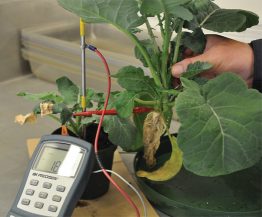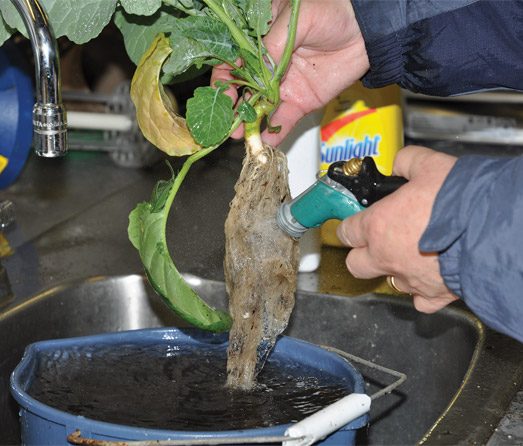Growing Forward 2 projects
PLANT ESTABLISHMENT
Seed size and seeding rate effects on canola yield and quality
LEAD RESEARCHER: Neil Harker, Agriculture and Agri-Food Canada (AAFC), Lacombe, AB
PURPOSE: With continual canola improvement and cultivar changes, a re-examination is necessary to find the optimal seed size and seeding rate for canola production in terms of impact on crop emergence, growth, yield and quality.
PROGRESS: Higher seeding rates increased early crop biomass, thousand-seed weights and seed oil content, and reduced both the number of days until the beginning of flowering and days to crop maturity. Increasing seed size also increased early canola biomass and thousand-seed weights. Days to flowering and days to the end of flowering decreased with increasing seed size. Seed size effects on canola emergence, yield or seed quality were not significant.

Investigating tolerance of canola genotypes to heat and drought stresses, and estimating root traits by electrical capacitance
LEAD RESEARCHER: Bao-Luo Ma, AAFC Ottawa, ON
PURPOSE: To develop knowledge and technology for selection of canola genotypes with better tolerance to heat and drought stresses.
PROGRESS: A non-destructive method for measuring canola root size was developed and used in subsequent experiments. In the field experiment, early May planting produced better yields than the earliest planting in April and both the late May and early June plantings (which produced the two lowest yields). Increasing seeding rate from 2.5 to 5.0 kg/ha (roughly 2.5 to 5.0 lb./ac.) also increased seed yield for early-seeded canola, though further increases didn’t augment yield. Growth chamber results revealed that early flowering stage may be a critical period for canola genotypes sensitive to heat and drought stresses and for causing flower abortion. Selection for high root capacitance may also be used as a simple indicator for mitigating heat and drought stresses.

Canola rotation studies
LEAD RESEARCHER: Claude Caldwell, Dalhousie University, NS
PURPOSE: This project is built on an established rotation experiment and aims to gain a better understanding of how canola will fit into existing cropping systems.
PROGRESS: A four-year, three-location (Canning, NS, Ottawa, ON and McGill, QC) study with canola, wheat, soybean and corn in various rotations determined that continuous crop rotations showed a tendency to yield less than non-continuous rotations. Other than the continuous canola rotation, canola did not show any significant effect on the yields of following crops. Similarly, preceding crops did not show any significant effect on canola yields. However, wheat crops tended to yield greater when following canola than other crops.
FERTILITY MANAGEMENT
Variable N fertility management of canola at the field scale, based on analysis of yield maps and spatial and statistical variability of soil test N and P
LEAD RESEARCHER: Alan Moulin, AAFC Brandon, MB
PURPOSE: To examine variable rate nitrogen fertility programs in terms of: the impact on canola yield in areas with consistently high production; the economic return and efficiency of fertilizer use; the relationship between the variability of canola yield and soil test nitrogen and continued on next page phosphorus; variability related to soil test recommendations; and the correlation between digital elevation, landform and remote sensing data and canola yield.
PROGRESS: In 2014 and 2015 field scale trials with varying fertilizer treatments (0, 50, 100 and 150% of soil test recommendations for N) were tested in low, average and high producing field zones. Canola yield in 2014 generally increased with increasing nitrogen fertilizer rates and varied between low, average and high zones. Yield data were collected in 2015 and are awaiting analysis.
INTEGRATED PEST MANAGEMENT
Characterization and development of new resistant sources for sustainable management of clubroot in canola
LEAD RESEARCHER: Gary Peng, AAFC Saskatoon, SK
PURPOSE: To investigate the resistance mechanisms of different clubroot resistance (CR) genes. These potential novel CR genes could provide industry with opportunities to incorporate more effective genes into canola cultivars to increase the durability of clubroot resistance.
PROGRESS: This collaborative (AAFC Saskatoon, University of Alberta and University of Manitoba) project has made progress with marking and mapping genes that control clubroot resistance in related species. The researchers have developed molecular markers for CR genes in B. napus, which allowed different CR genes to be transferred from B. rapa into canola. They have also developed double haploid lines and evaluated them for agronomic and quality traits.
The host-pathogen interaction of Plasmodiophora brassicae
and canola
LEAD RESEARCHERS: Sheau-Fang Hwang, Alberta Agriculture and Forestry, and Stephen Strelkov, University of Alberta
PURPOSE: To investigate the host pathogen interactions in the clubroot patho-system in order to guide the industry, management options and resistance-breeding decisions.
PROGRESS: The researchers have determined in greater detail the roles of primary and secondary zoospores in clubroot pathogenesis. They have also developed protocols to genetically transform P. brassicae. A draft genome of the pathogen is now being assembled to help the researchers better understand how P. brassicae causes clubroot disease. In addition, differential host cultivars were identified and will be further evaluated so the researchers can develop a Canadian clubroot differential set to more effectively characterize new strains of P. brassicae.
Management of clubroot in a dynamic environment
LEAD RESEARCHERS: Sheau-Fang Hwang, Alberta Agriculture and Forestry, and Stephen Strelkov, University of Alberta
PURPOSE: To develop economical and effective techniques to eradicate localized clubroot infestations using soil fumigants; to assess the impact of crop rotations that include clubroot resistant canola varieties on clubroot pathogen population dynamics in the soil; and to optimize practices for disinfesting agricultural and industrial equipment that has been contaminated with clubroot-infected plant material and/or soil-containing spores.
PROGRESS: Results indicate that non-host crops in rotations with at least a two-year break between canola crops reduce clubroot severity. Soil fumigation results strongly suggest that the fumigants tested may have potential as a tool to contain localized infestations of P. brassicae, particularly when the pathogen is not yet well established.
Clubroot surveillance and epidemiology
LEAD RESEARCHER: Stephen Strelkov, University of Alberta
PURPOSE: To stay ahead of clubroot disease in Western Canada through continued clubroot surveillance; to track the prevalence and predict the spread of clubroot; to monitor pathogen populations for pathotype shifts; and to evaluate clubroot resistance in fields.
PROGRESS: There were 103 new cases of clubroot found in the 648 commercial canola crops surveyed across Alberta in 2014. All severe clubroot cases were found on susceptible hybrids or hybrids of unknown resistance. In the canola crops confirmed to be resistant hybrids, symptoms of clubroot were generally absent or very mild. Nonetheless, some resistant cultivars with higher than expected levels of clubroot were found, and the corresponding P. brassicae populations will be isolated and tested for any shifts in virulence patterns. An additional 279 new records of pathogen infestation were reported by collaborating municipal personnel, for a total of 382 clubroot-infested fields in 2014.
Aster yellows and swede midge: New threats to prairie canola production
LEAD RESEARCHER: Owen Olfert, AAFC Saskatoon, SK
PURPOSE: To investigate the distribution, economic impact, thresholds, host plant resistance, and management of aster yellows vectored by leafhoppers and swede midge in western Canadian canola production.
PROGRESS: Swede midge survey results found that populations are increasing and have spread westward across Saskatchewan. Fortunately, economic impact was mitigated by how late in the season swede midge appeared. Regarding management options, preliminary results showed that Camelina sativa was less damaged by swede midge than other crucifers, and it may provide a source of resistance to the pest. Collection of two undescribed parasitoids of swede midge added to potential management options. Aster yellow survey results showed incidence was very low in leafhopper populations and in canola fields in 2015, although leafhoppers were present and reproducing in neighbouring cereal fields. In 2015 Macrosteles quadrilineatus, the aster leafhopper, was the only leafhopper species to test positive for the disease, at a level of 1% of all leafhoppers tested.
Development of pest management decision-making protocols for the swede midge in canola
LEAD RESEARCHER: Rebecca H. Hallett, University of Guelph, ON
PURPOSE: To develop pheromone-based action thresholds for swede midge in canola and to optimize insecticide application timing (in terms of plant growth stage) for maximum yield protection. This is especially necessary because swede midge have multiple, overlapping generations each year and canola plants are susceptible to damage at multiple growth stages.
PROGRESS: Strip trials found that multiple insecticide applications were required to reduce swede midge damage, and early or mid-timing applications were more effective than later ones. Early applications should be made when a cumulative ≥20 midges are captured (based on four pheromone traps per field with swede midge counts beginning at the cotyledon stage) prior to the four-leaf stage. In addition, in preliminary pheromone-based action threshold trials, no differences were reported between the pheromone and plant stage based insecticide timing treatments, despite the use of an additional spray in the latter.
Improved integrated crop management with beneficial insects
LEAD RESEARCHER: Julie Soroka, AAFC Saskatoon, SK
PURPOSE: To investigate the phenology of diamondback moth larvae and its parasitoids (including its principal parasitoid Diadegma insulare) in four eco-regions of Saskatchewan at three different times in the canola growing season.
PROGRESS: Considerable information about the effects of temperature on the development of both diamondback moth and D. insulare was collected. New recorded minimum temperature thresholds for the survival of both diamondback moth and D. insulare were reported. Also, the expression of a heat shock protein in both diamondback moth and D. insulare was revealed and may provide a viable means of tracking arthropod responses to changing climates. Overall, three scientific publications based on this project are in press or have been published and two other manuscripts are in progress.
Canola sustainability: Risk mitigation
LEAD RESEARCHER: Neil Harker, AAFC Lacombe, AB
PURPOSE: To determine if the risks of growing canola in tighter rotations can be mitigated by: planting different cultivars in subsequent years; adding inputs that are higher than normal (fertilizer, seed); or unusual practices (such as enhanced seed treatment, chaff removal, or mixing cultivars at seeding).
PROGRESS: While there have been trends for successful mitigation in some treatments, none of these strategies have worked as well as simply rotating canola with another crop such as wheat or field pea. When canola cultivars can be classified according to their specific blackleg avirulence genes, cultivar rotations will be better designed and seed mixing strategies will be more effective.
The environmental footprint of canola and canola-based products
LEAD RESEARCHER: Vern Baron, AAFC Lacombe, AB
PURPOSE: To study farm-gate canola carbon footprints and determine the greenhouse gas intensity for canola production using best management practices in a high yield and high input region
PROGRESS: The major contributors to farm-gate canola footprint were the production and use of fertilizers and the use of field equipment for on-farm practices and tillage. The environmental profile of canola production per tonne has improved since 1990 and the carbon footprint was reduced between 1990 and 2010. Reductions in environmental effects were the result of increased yields and plant biomass, the adoption of herbicide tolerant and hybrid canola, and improved crop production management practices. These practices included the shift to conservation tillage and direct seeding, as well as improved weed management strategies. The field study showed that early-planted canola provided a higher net income but had higher nitrous oxide emissions, while all treatments sequestered more carbon than they released through respiration.
Operational models to forecast canola growth stage, sclerotinia risk and yield in Western Canada
LEAD RESEARCHER: Rishi Burlakoti, Weather Innovations
PURPOSE: To develop models for forecasting canola growth stage, sclerotinia stem rot risk and canola yield on a near real-time basis.
PROGRESS: Preliminary results from the 2014 small plot and field-scale trials show that current varieties require more heat units than older varieties, especially from flowering to maturity. The highest sclerotinia stem rot incidence was observed in the small plot trials and the short season variety was the most affected. The yield prediction model that was tested underestimated overall yield, indicating that more work must be done in yield modeling. A preliminary phenology model is still in progress and will be updated and fine-tuned as more phenological data becomes available.
HARVEST MANAGEMENT
Feasibility of bag storage systems for canola storage under Prairie conditions
LEAD RESEARCHER: Digvir S. Jayas, University of Manitoba
PURPOSE OF STUDY: To investigate the feasibility of bag storage systems for canola on the Canadian Prairies by quantifying canola quality values throughout the storage duration.
PROGRESS: Results determined that canola seeds with moisture content of eight percent or less could be stored for 10 months in silo bags. Seeds with 10 percent moisture could be stored for seven months without seed quality deterioration and seeds with 12 percent moisture could maintain their grade if unloaded before the ground thawed. Also, the application of lime (calcium carbonate) on the ground of the silo bag site can reduce rodent activity.





